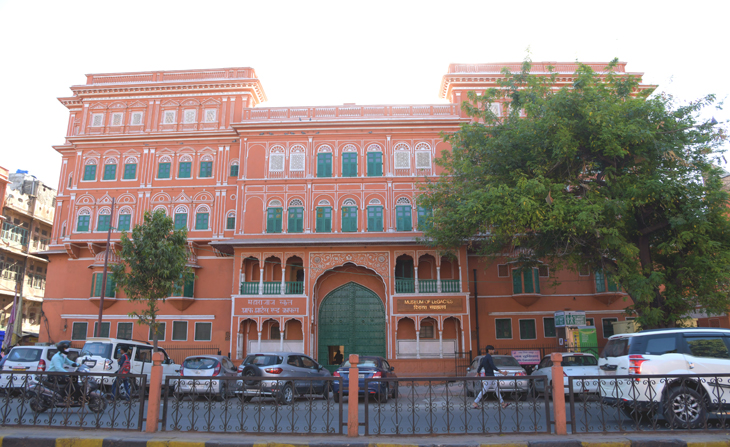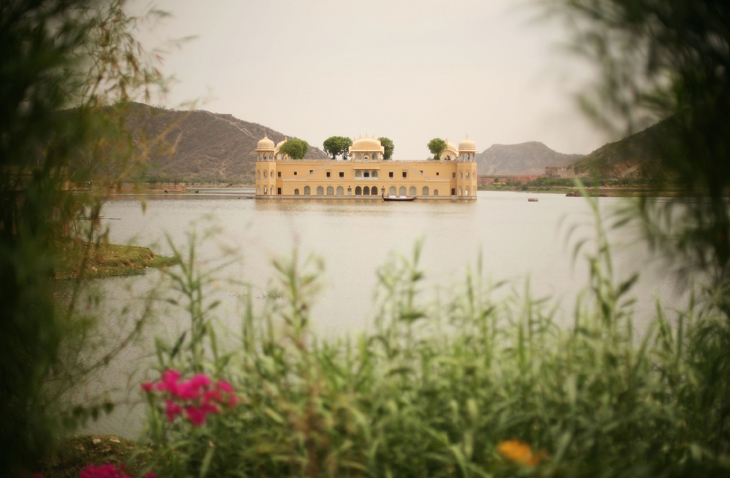‘I’d had this idea for many years about putting large-scale sculptures in that fort’, says Peter Nagy, a Manhattan artist and gallerist who transplanted himself to Delhi in 1997 to be an early champion of Indian contemporary artists. ‘That fort’ he refers to is the great hilltop Nahargarh Fort that overlooks Jaipur, a city more associated with Rajput palaces and folk arts than modern art installations. Nagy’s first show there – works by Indian and international artists including Jitish Kallat, Subodh Gupta, and Thukral & Tagra scattered through the rooms and courtyard of the fort’s Madhavendra Palace – landed in the city with a welcome shock in December. ‘I wanted it to be a bit of a treasure hunt. We’ve had 6,000 people a day, often locals who’ve never been to an art show. Kids dashing about, clambering on top of Sabodh’s Ambassador car and running along it. We specially chose robust pieces!’
That this show has such tremendous local success is perhaps its real triumph. Most of India’s contemporary and modern art spaces draw the already-knowing rather than the local curious with few previous art encounters. When I visited it, the palace was filled with visitors. A group of women stood in front of Vibha Galhotra’s Flow (2015), in animated discussion over what seemed to be moulton lava oozing out of a delicately painted palace wall, frozen in time. Courting couples strolled around and posed for selfies with Thukral & Tagra’s Arrested Image of a Dream – Stone Wings (a) & (b) (2015), two monumental carved wings intended to evoke ancient cultures. A young man hovered pensively in front of Arlene Shechet’s series of Buddha figures, made between 1994 and 2000. Families with kids of all ages dispersed upstairs and along corridors, calling out from windows to tell each other about the amusing, strange, provocative sculptures they had discovered.

Arrested Image of a Dream – Stone Wings (a) & (b) (2015), Thukral & Tagra. Installation view at the Sculpture Park at Madhavendra Palace, 2017. Photo: Dhruv Malhotra; courtesy Saat Saath Arts
In a land of government bureaucracy, Nagy seems slightly stunned that the project was realised so quickly. The key step was getting Vasundhara Raje, Rajasthan’s chief minister since 2013, on side. ‘She was persuaded that people travel to India for contemporary as well as traditional Indian culture,’ says Nagy. Rajasthan has six forts designated as world heritage sites by UNESCO; Nagy chose Narhargarh because it has ‘it had a lot of possibilities, and it is the right scale. It’s neatly contained and has security’. Last March a 10-year-long partnership agreement to run the sculpture park was signed by the Rajasthan government and Saat Saath Arts Foundation, a non-profit founded by Nagy’s co-director at Nature Morte, Aparajita Jain, which provides fundraising and support for art and education initiatives in India to promote international exchange. (Raising funds in India has become much easier since the Companies Act of 2013, which introduced mandated corporate social responsibility – the requirement that two per cent of a national company’s profits to be spent on philanthropy.) Nine months later, in December, the park opened.

Flow (2015), Vibha Galhotra. Installation view at the Sculpture Park at Madhavendra Palace, 2017. Photo: Dhruv Malhotra; courtesy Saat Saath Arts
The current exhibition is scheduled to run until November, and Nagy already has the next show mapped out: ‘For this exhibition, the pieces already existed. For the next, we want to use even more of the space, have all new works. We hope to have 50/50 Indian and non-Indian artists; ten artists doing ten works each. We have some local artists making site-specific pieces; we have Richard Long using local materials.’
At Nahargarh Fort, the combination of public and private funding in support of a creative vision to revive a historic site seems to have been a triumph. It’s not the only project working with the state or central governments to revive spaces in Jaipur – to varying degrees of success. The state-funded Jawahar Kala Kendra (JKK), intended to be a hub for Rajasthani culture, had been languishing since soon after its colourful, lavish auditorium and galleries designed by Charles Correa were completed in 1993. Now Pooja Sood, director since 2015, has breathed new life into it. In January this year, she relaunched its nine-acre site with a schedule that ranged from films by Mani Kaul and Ranbir Singh Kaleka to a packed all-night performance of Indian classical dance. It’s not clear if funding is secure for the centre’s future.

Exterior of Museum of Legacies, Jaipur, Rajasthan. Photo: courtesy Museum of Legacies
The second revival is at Kishanpole Bazar, inside Jaipur’s old walled city, where a 64-room mansion built for a court minister in the 19th century has been turned into the Museum of Legacies. Funding came from the Government of India’s Smart Cities Mission, a $15 billion cross-country programme for urban renewal and sustainability launched in 2015. The museum’s first five spaces opened in the same month as the Nahargarh Fort sculpture park – on view are the very finest examples of Indian crafts, from Mitch Crites’s collection of marble and stone inlay-carvings to Pooja Singhal’s collection of Pichwai paintings. More galleries, workshops and summer programmes are planned for when promised government funding arrives. Apurba Roy Choudhury, its curatorial director, wants it to be ‘an alive, vibrant place and play a pivotal role in making Jaipur a quality cultural capital’.

The Jal Mahal palace on Man Sagar lake, photographed in 2010. Photo: Mark Kolbe/Getty Images
Then there’s the Jal Mahal palace, which seems to float on the Man Sagar Lake – a wondrous building with a fragile future. Having become dangerously polluted, the lake was dredged and cleaned so water-birds returned. The palace itself, built for royal duck-shooting parties, has been restored from a state of decay using traditional methods. Jaipur’s miniature painters have decorated the walls of its loggias and pavilions; the rooftop garden is furnished with fountains and flowers. You would reach this idyll by boats with swan-shaped prows – had the state government not made palace and lake a ‘protected area’ closed to visitors. What began with government encouragement in 2000, then become a public-private partnership, now languishes in court.
Jaipur city was conceived by Maharaja Jai Singh II in the early 18th century, in response to the weakening of Delhi’s Mughal rulers, to be an ideal city, the successful trading and cultural hub of north India. Today, Jaipur’s movers and shakers are again embracing the city founder’s aim – albeit with the occasional one step back for every two steps forward – to benefit today’s three or so million citizens as much as their visitors.
The first edition of the Sculpture Park at Madhavendra Palace, Nahargarh Fort, Jaipur, Rajasthan, runs until November 2018.














![Masterpiece [Re]discovery 2022. Photo: Ben Fisher Photography, courtesy of Masterpiece London](http://zephr.apollo-magazine.com/wp-content/uploads/2022/07/MPL2022_4263.jpg)
‘Like landscape, his objects seem to breathe’: Gordon Baldwin (1932–2025)